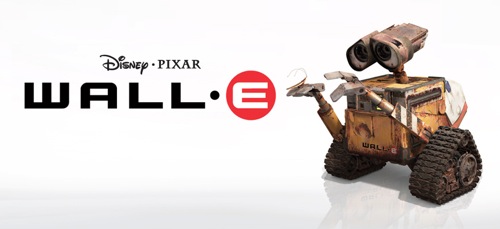
This weekend, I watched Disney/Pixar’s latest film WALL-E for the first time. What a phenomenal film. Pixar proves once again what a powerhouse they are.
First, the visuals. Absolutely breathtaking. Several shots in the film were hard to separate as 3D-generated they looked incredibly realistic. The lighting, the shading and textures of the models, the reflections, the depths of field, and more all combined to create this incredibly realistic fictional world. What a talented group of visual artists Pixar has working for them. One particular shot I remember being so amazingly realistic-looking is an extreme close up of the top, front of WALL-E’s unresponsive eyes as EVE leaned in toward him. Outstanding work. I can’t use enough adjectives to describe the visual work on this film.
A significant portion of the film and its characters are voiceless (well at least without a human voice). Not having characters with speaking voices could prove to be tragic if special care were not taken to ensure proper communication cues were present as replacements, cues such as animation conveying excitement, sadness, etc. We could tell what kind of mood EVE was in by the shape of her eyes. But complementing and perhaps surpassing the visual cues were the auditory ones. The sounds each robot made, from short beeps and blips to more emotion-filled sounds of longing and excitement, gave the audience a method to connect with the characters through personification. Ben Burtt, the veteran Hollywood sound designer, gave voices to the robots and made their world just a little more believable.
So much of the film was magical. From EVE and WALL-E’s dance in space to WALL-E showing EVE the bubble wrap to the loyal band of “broken” robots who had uses for their malfunctions after all to the little lunch box WALL-E transports his keepsakes in.
But, like in any film, the key component to a magical film is the story, and WALL-E had a fantastic story, one of hope and love. The hope lies in the state Earth is in, a state thanks to humanity’s carefree laziness, consumerism, materialism, and ignorance of self- and communal-health. What today may be a cool new thing will be the downfall of us and everyone around us tomorrow. Even after we wander past what is reasonable, healthy, and judicious, there is still a little green hope waiting to bring us back. The lesson here for us real humans, though, isn’t that we should wait for our wasteful ways to one day be rectified by something outside of our doing, but instead for us to alter our self-made path to destruction now while we still have the chance. Hope, then, is something we can find in ourselves.
What else we can find in ourselves in love. Love for ourselves, love for someone else, and love for each other. I don’t think I’m giving anything away here by saying the romantic component of WALL-E revolves around the relationship between WALL-E and EVE. The love and longing WALL-E feels toward EVE reflects the most basic of human feelings the need to love and be loved; the need for a companion. Once we find that perfect love, we will stop at nothing to pursue (clasping onto the spaceship), help (with EVE’s directive), and protect (from the rain and elements) said love.
These two themes of hope and love allow us to connect with the characters and reflect on our own lives through the characters. Even the quirks of the robots give us the ability to see bits of ourselves (who doesn’t love popping bubble wrap or collecting little trinkets?).
Finally, I, along with every other Mac geek around, gleefully smiled when WALL-E made his reboot sound the sound of a powering-up Apple computer.
WALL-E is an exceedingly outstanding film, from the visual and aural presentation, to the basic building blocks of a solid, successful story. While the film is comprised of artificial beings in an artificial world, the characters’ passions and emotions are those humans encounter every day, and they invite us to reflect in our own realistic world of hope and love.